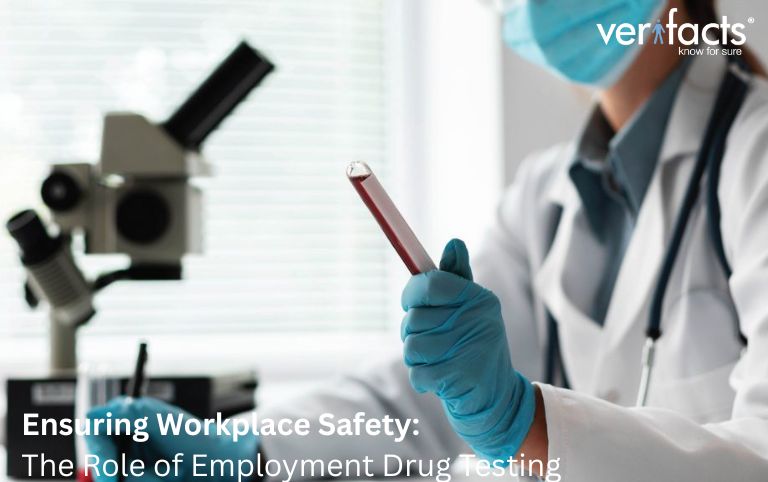
Employment drug testing has become an essential part of modern workplace protocols, ensuring that organizations can maintain a safe, productive, and compliant environment. By screening for substances such as illegal drugs, alcohol, and even the misuse of prescription medications, employers can minimize risks and foster a culture of accountability. Understanding the importance, types, timing, and legal aspects of drug testing enables HR leaders and employers to implement effective strategies that benefit both organizations and employees.
Drug testing is not just a compliance measure—it plays a pivotal role in shaping workplace culture and business outcomes:
-
Enhancing Workplace Safety 🦺
Safety-sensitive industries such as construction, transportation, and manufacturing are particularly vulnerable to risks caused by substance abuse. According to the National Institute on Drug Abuse (NIDA), 65% of workplace accidents are linked to substance misuse. Regular testing ensures impaired employees are identified early, reducing accidents and protecting co-workers, customers, and company assets. -
Maintaining Productivity 📈
Substance use directly affects performance, resulting in absenteeism, reduced concentration, and frequent errors. Employees with substance use disorders are 2.5 times more likely to miss work (SAMHSA). Drug testing ensures companies maintain consistent quality and output while minimizing the hidden costs of lowered productivity. -
Legal and Regulatory Compliance ⚖️
Certain sectors are bound by strict regulations mandating drug testing. For instance, in India’s aviation industry, employees undergo rigorous drug and alcohol checks to meet safety standards. Similarly, in the U.S., the Department of Transportation (DOT) enforces mandatory drug testing. Non-compliance may result in heavy penalties, lawsuits, or loss of licenses. -
Protecting Company Reputation 🌍
A drug-free workplace promotes trust and professionalism, both internally and externally. Organizations known for prioritizing safety and ethics build stronger relationships with clients, stakeholders, and customers, enhancing brand reputation and opening new business opportunities.
Employers can choose from various testing methods depending on the role, industry, and nature of risk:
-
Urine Testing 🚾 – The most common and cost-effective method, suitable for pre-employment and random checks. It detects recent drug use effectively.
-
Hair Testing 💇 – Captures long-term drug use patterns for up to 90 days, making it ideal for identifying habitual use. Though more expensive, it provides highly accurate insights.
-
Blood Testing 💉 – Provides immediate and precise results, useful in post-accident or emergency situations where recent impairment is in question.
-
Saliva Testing 👅 – A non-invasive method offering quick results within 24–48 hours. It is especially practical for on-the-spot testing.
-
Sweat Testing 💦 – Conducted through skin patches, this method continuously monitors drug use over extended periods, often used in rehabilitation or monitoring programs.
Drug testing is not random—it is strategically applied to maintain organizational integrity:
-
Pre-Employment Screening 📝 – Ensures candidates meet drug-free standards before being hired, reducing future risks.
-
Random Testing 🎲 – Conducted without prior notice to deter substance abuse and maintain a culture of accountability.
-
Post-Accident Testing 🚑 – Helps determine whether drug use contributed to workplace incidents, strengthening liability management and prevention strategies.
-
Reasonable Suspicion Testing 👀 – Initiated when an employee shows behavioral or physical signs of substance misuse, supported by credible observation.
Employers typically screen for substances that can impair judgment, reaction times, and workplace safety:
-
Marijuana 🌿
-
Cocaine ❄️
-
Opiates 💊
-
Amphetamines ⚡
-
Phencyclidine (PCP) 🧬
Each substance has a different detection window, making the choice of test type critical to accurate results.
A drug testing program must comply with federal, state, and industry-specific laws while ensuring fairness and transparency:
-
Employee Rights & Privacy 🔐 – Employers must balance safety with respect for individual privacy and avoid discriminatory practices.
-
Compliance with Laws 📜 – Regulations such as the ADA (Americans with Disabilities Act), OSHA, and India’s aviation safety laws define the boundaries of drug testing.
-
Consequences of Positive Results ❌ – Employers should have clear policies outlining disciplinary actions, such as termination, counselling, or rehabilitation programs, depending on company policy and legal frameworks.
A successful drug testing program requires structured planning and fair execution:
-
Policy Development 📑 – Draft a transparent policy specifying the purpose, testing methods, substances screened, and consequences of results.
-
Employee Communication 📢 – Educate employees about the importance of drug testing, their rights, and how the process is conducted to build trust.
-
Fairness and Confidentiality 🤝 – Ensure consistent application across all employees, maintain strict confidentiality of results, and provide equal treatment without bias.
Employment drug testing is not merely an HR protocol—it is a strategic safeguard for organizations aiming to protect their people, brand, and productivity. By understanding the types of tests, legal frameworks, and implementation best practices, employers can build a safer, more accountable, and drug-free workplace.
🌟 In today’s competitive environment, organizations that adopt fair and transparent drug testing policies foster trust, reduce risks, and enhance overall workplace culture.

